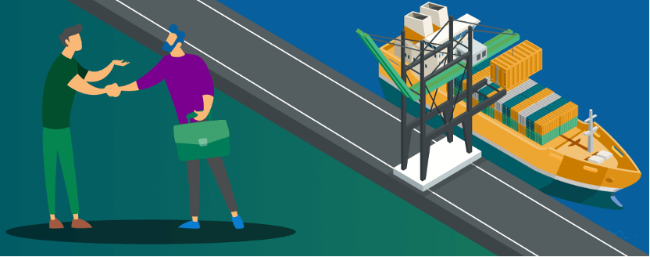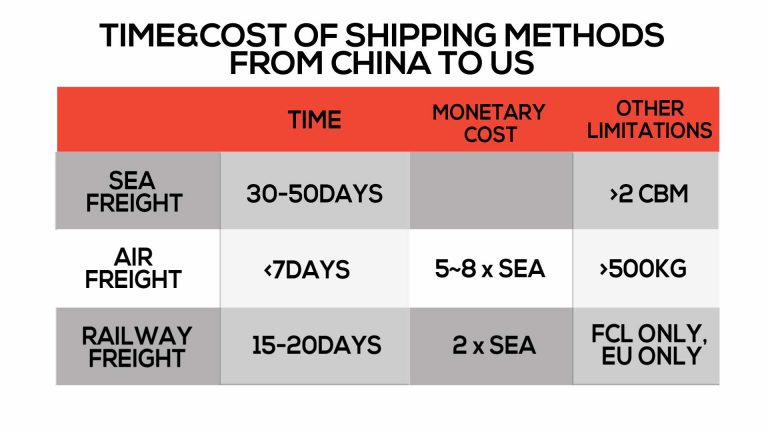Guide to Shipping from China: Choosing the Best Shipping Solution
Transporting products from China to the rest of the world is a complex and critical task for importers. Many importers are looking for a better balance between transportation time and cost. This article will provide you with a comprehensive analysis of the mainstream transportation solutions on the market, helping you to accurately select the mode of transportation that best suits your business needs, regardless of whether you are transporting small or large shipments.
In the international shipping process, there are four key roles:
I.the role of transportation participants
There are four main key players in the international shipping process:
- Shipper: i.e. your product supplier.
- Consignee: i.e. you.
- Transportation Company: the company that owns the trucks, boats or airplanes that are responsible for moving the product from point A to point B. The transportation company is responsible for the delivery of the product. Often, different transportation companies need to work together to complete the entire process. You do not need to be in direct contact with the transportation company.
- Freight forwarders: play a crucial role in the transportation process. You or your Chinese suppliers need to find the right freight forwarder. They act as brokers, coordinating the many shipping companies that pick up the goods from the supplier and deliver them to you. They also take care of the import and export process.
There are many freight forwarders around the world, either large companies or individuals. It can be difficult to recognize their trustworthiness, as some agents will quote low prices and then increase costs by measuring the dimensions of the goods or charging extra fees. If you don’t know much about freight forwarders, you can ask your supplier to help you find one. Although they will make a profit on the freight cost, the supplier will be responsible for any loss or damage to the goods in transit, which is relatively safe for novice importers. If you prefer a freight forwarder who is directly responsible for you, ask for a recommendation from someone you trust, do a Google search, or use platforms such as Freightos, Flexport, etc. to find one.
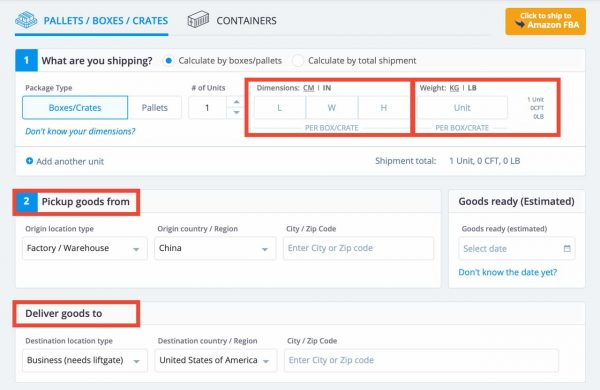
Freightos is easy to use. Once you have entered the volume and weight of your shipment, as well as the city of pickup and delivery, you will be able to get a list of freight forwarders and their quotes, similar to the process of booking an airline ticket. However, it is important to note that you can only contact a freight forwarder once you have completed your online payment, and the quotes you see are for shipping to the destination city, not your home address, so you will need to communicate with the forwarder to confirm the total cost. After trial, we found that Freightos is suitable for traditional sea or air transportation to North America, the United Kingdom, Western Europe, Australia and other regions, for other modes of transportation or countries, it is recommended to find another freight forwarder.
II.Master the core trade terms
Before shipping, it’s important to be clear about the trade terms that apply to your order, which define the responsibilities of both buyer and seller in terms of product delivery. When requesting a quote from a Chinese supplier, be sure to inform them of the terms on which the quote is based in order to avoid unexpected additional costs. Below you will find a brief overview of the five most commonly used trade terms:
- ExW (Ex Works): You will need to arrange for your own personnel to pick up the product at the supplier’s warehouse. Under this term, the product is priced at cost only and the supplier does not provide any transportation or export services.
- FOB (Free On Board): The supplier is responsible for paying all the costs of transporting the goods to the seaport or airport in China, as well as the export costs. You only need to contact the freight forwarder to pick up the goods at the port. However, if you choose to ship the goods via FedEx, UPS, etc., you should pay the supplier according to the ExW terms, because the courier company picks up the goods at the supplier’s warehouse instead of the port, and the courier freight covers all the costs from the supplier to you.
- CIF (Cost plus Insurance and Freight): The supplier will find its own freight forwarder to cover all the costs from its warehouse in China to the seaport or airport in your country. You only need to arrange for the freight forwarder to pick up the goods at the port in your country, handle the import customs clearance and then deliver the goods to you.
- DDU (Delivered Duty Unpaid) vs. DDP (Delivered Duty Paid): The supplier will find a freight forwarder and pay all the costs to deliver the goods to you. The difference is whether the supplier pays import duties or not.
The above is only the basic definition of trade terms, if you want to understand its application in the actual business, you can refer to the relevant actual case studies.
III.Efficient choice for goods below 500kg
For many e-commerce sellers as well as budding importers, courier service is a key and indispensable part of daily operations. With its easy operation and rapid delivery, it stands out among many transportation modes. Despite its relatively high price, it is still favored by most Chinese suppliers and is widely used in various business scenarios.
Advantages of Express Service
- Fast speed: most countries/regions can be delivered in only 3-5 days.
- Easy customs clearance: less proof of compliance is required than other shipping methods, making it the easiest way to complete import customs clearance.
- Transparent shipping costs: charged per kilogram, same unit price for shipping to any address within the same country.
Freight Explanation
- Changes in cost: Changes with destination and shipping market demand, usually shipping cost from China to North America and Western Europe is about $6-7 per kilogram, Asian countries are cheaper and other regions are more expensive.
- Peak Season Impact: The month before Lunar New Year and Christmas is the most expensive period, special events (such as the 2020 epidemic) may lead to price doubling.
- Small Parcel Costs: Shipping costs for small parcels under 20 kilograms are expensive, with a minimum cost of about $20, regardless of the weight of the shipment.
Therefore, it is not unusual for a sample to cost $20 USD to ship. However, when merchants ship large quantities, the average courier cost per bottle decreases as the size of the shipment increases and tends to a reasonable level, around 1 USD.
How to use courier services efficiently
When shipping products via courier, do not contact courier companies such as FedEx directly, as their official prices are higher. Often, Chinese suppliers will assist in finding couriers, and these companies can receive discounts of more than 40 percent from couriers due to their large shipment volumes. At the beginning of the outbreak, FedEx in China had limited shipments to 100 kilograms per day for most corporate accounts, making shipments difficult. Customers are advised to contact their local FedEx for pickup in China to circumvent the volume limit.
Knowing the volume and weight is key to choosing a courier for your shipment. Shipping rates are not based on weight alone, but size is also a factor. For example, a batch of large empty boxes, weighing only 10kg, with a volume of 1 cubic meter; another batch of boxes of the same size, full of products, with a total weight of 300kg. courier companies will convert the volume of the shipment into volumetric weight, and compare it with the actual weight, and bill the larger one. Most international courier companies calculate the volume of the weight of the formula: length (cm) × width × height ÷ 5000. Therefore, 1 cubic meters of empty box volume weight of 200 kg, the freight charged at 200 kg. For products with large volume but low value, such as toilet paper and disposable tableware, air express is not cost-effective, and the express fee may be higher than the value of the product itself. In addition, lithium batteries, liquids or powders are not allowed to be transported by air. If air transportation is required, some Chinese courier companies can undertake it, but the cost is at least 50% higher.
IV. Sea freight cost for goods above 2CBM
Ocean freight, the most common mode of transportation in traditional trade, is favored for its low cost. Unlike courier services, the shipping and customs process for ocean freight is not run by a single large company like FedEx. Rather, you or your product suppliers need to carefully select and work with a freight forwarder to complete this complex and cumbersome transportation task.
How Ocean Freight Works and Who’s Involved
Freight forwarders play a vital role in the vast network of ocean transportation. They have a number of key responsibilities including, but not limited to, arranging for trucks to pick up the goods from the supplier’s warehouse, booking the right containers with the ocean freight company, finding a professional customs broker to properly complete the import/export process, and finally arranging for the trucks to deliver the goods from the port to your warehouse in a safe and on-time manner. This series of interlocking operations constitutes the complete operational process of ocean freight.
Numerous individuals and small companies are active in this field, offering a wide variety of ocean freight services. However, compared to express services, their quality of service varies, and most of them are not equipped with a comprehensive website tracking system, which undoubtedly brings some inconvenience to customers in real-time status of cargo transportation.
Container transportation and cost considerations
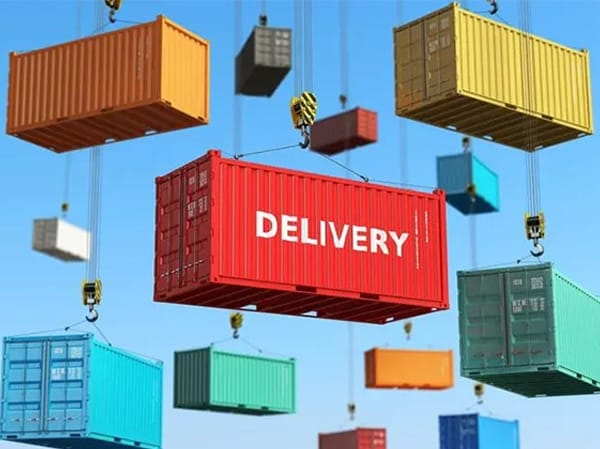
The core vehicle for ocean freight transportation is the container, with 20-inch and 40-inch containers being the most common, with volumes of up to 28 cubic meters and 68 cubic meters, respectively. When your cargo volume exceeds 20 cubic meters, the best option is to have a freight forwarder book a full container (FCL) for you. This not only ensures centralized transportation of your cargo, but also increases the efficiency of transportation to a certain extent.
For smaller shipments, Less-than-Consolidated Container (LCL) transportation becomes a more economical option. Through LCL, your freight forwarder will skillfully load your cargo and other customers’ cargoes together in a container, thus realizing a significant reduction in transportation costs, allowing you to enjoy the advantages of low cost of ocean freight while also having the flexibility of transporting small quantities of goods.
However, if your shipment volume is less than 2 cubic meters, ocean freight may not be your first choice. Because ocean freight has a fixed cost of hundreds of dollars per shipment, the average cost per cubic meter can become quite high when the volume is small. In addition, ocean freight’s long lead times can pose a challenge to your business operations and reduce capital turnover.
Components of Ocean Freight Costs and Fluctuating Factors
The calculation of ocean freight costs is more complex than for express shipments, and covers the cost of overland transportation from the supplier to the seaport in China, the cost of exporting, the cost of the ocean freight itself, the cost of importing, the cost of the seaport in your country or region, and the cost of overland transportation for the final delivery of the shipment to your warehouse. When you ask a freight forwarder for a quote, they will usually provide you with a detailed list of costs so that you can get a clear picture of what each cost is.
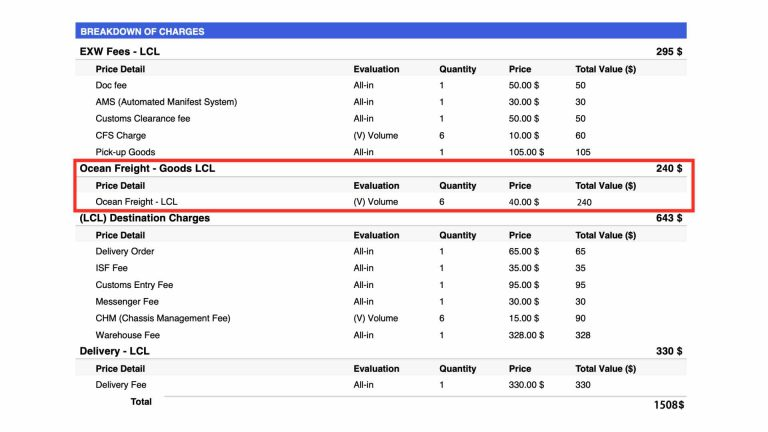
The cost of ocean freight itself is really only a relatively small part of the equation. The bulk of the cost is centered on handling at the port of destination, various handling fees during the importation process, and the cost of transporting the goods overland from the port to your designated address. For example, shipping a 40-inch, 68-cubic-meter container from a Chinese port to the United States or Western Europe would cost about $3,000 for the ocean freight portion under normal circumstances. However, during the peak shipping season, a month before the Lunar New Year, that cost can soar to $5,000. Even more staggeringly, the cost of shipping rises to $10,000 on the eve of the Lunar New Year in 2021, and $5,000 in 2020, more than double the normal price in the years prior to the outbreak.
Fluctuations in ocean freight costs are affected by a combination of factors, including but not limited to market supply and demand, fuel prices, transportation distances, seasonal factors, and global trade policies. Nonetheless, the key for customers is to have a general and clear estimate and understanding of the total transportation costs from China to your doorstep.
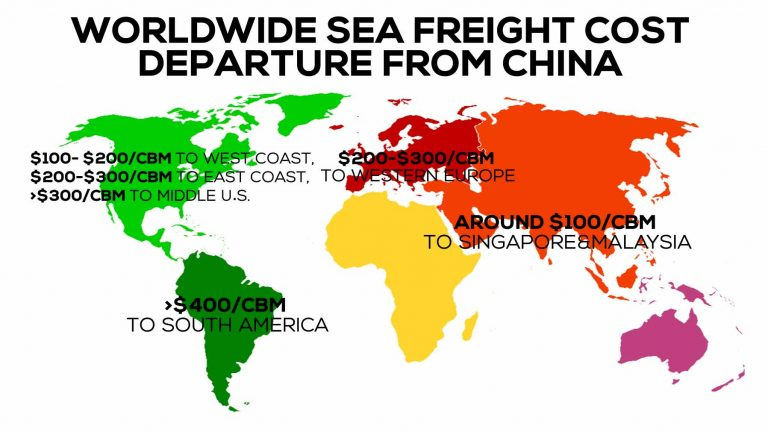
Shipping costs vary significantly depending on the destination. The cost of shipping to the nearby West Coast of the United States is in the range of about $100 - $200 per cubic meter, while the cost rises to $200 - $300 per cubic meter for shipments to the neighboring East Coast of the United States, and exceeds $300 per cubic meter for shipments destined for the central part of the United States. In Western Europe, shipping costs remain roughly in the $200 - $300 range, while for the far reaches of South America, costs can exceed $400 per cubic meter.
It should be noted that the above prices are pre-epidemic references. For recent and accurate quotes, it is advisable to check specialized platforms such as freightos.com. Generally speaking, the total freight cost of ocean freight is about 85% lower than that of air freight, and this significant price advantage makes ocean freight always maintain strong competitiveness in the field of bulk cargo transportation.
Consideration of sea freight transportation time
As the most cost-effective but relatively slowest transportation solution, the length of time it takes for sea freight to be delivered from the Chinese seaport to your doorstep is one of the most important factors that customers must take into account when choosing a shipping method. In addition to the time spent on sea transportation itself, the tediousness of the import process should not be underestimated. After the goods arrive at the port of destination, it is also necessary to set aside enough time to deal with the land transportation company to arrange the schedule of home delivery to ensure the smooth connection of the entire transportation chain.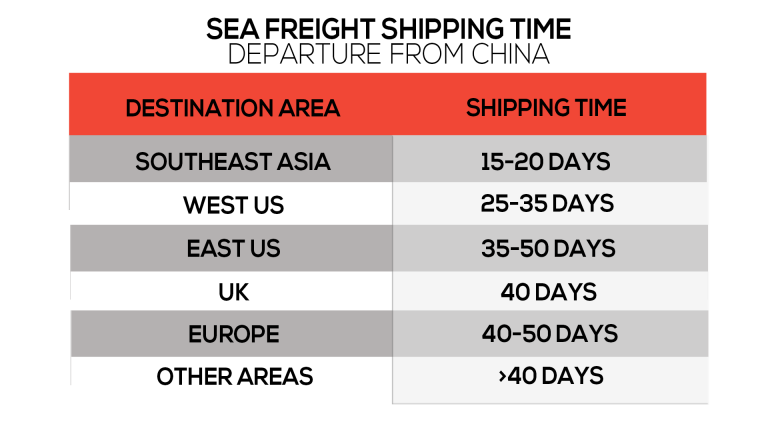
V. Airfreight transportation for cargoes over 500 kilograms
When cargo weighs more than 500 kilograms, air freight becomes a very cost-effective transportation option. Although both airfreight and express shipping use the power of air transportation, there are significant differences between the two.
The Essential Difference Between Air Freight and Express Transportation
In air transportation, there is no single courier giant like “FedEx”. Courier services are usually handled by a single large company, from the collection and transportation of goods, to import customs clearance, to the final delivery, every step of the process is closely controlled by the company to provide customers with a one-stop, seamless transportation experience. Unlike air freight, you or your supplier will need to actively seek out a professional freight forwarder to assist with the entire transportation process. The freight forwarder will play a key role in booking the right space from the airlines, finding a reliable customs broker to handle the import/export formalities, and arranging for trucks to deliver the goods safely and efficiently from the airport to your warehouse.
Advantages and Costs of Air Freight Transportation
- Price Advantage
The biggest advantage of airfreight over express delivery is the price. Air freight can save you up to 20% or more compared to express delivery. However, this advantage is only realized when the weight of the shipment exceeds 500 kilograms. This is because, like sea freight, air freight has a fixed operating cost per shipment. For shipments weighing less than 500 kilograms, express delivery is definitely the better option. Express services dominate the market for small shipments with excellent service quality, easy customs clearance and faster delivery times.
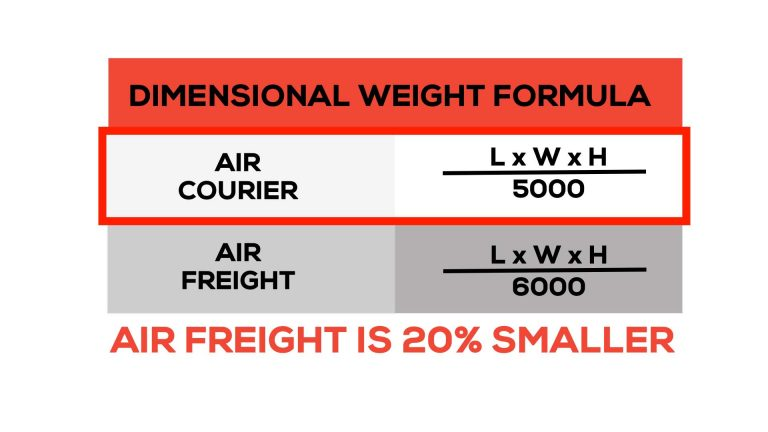
- Volumetric Weight Calculation Advantages
For the same volume, airfreight calculations are approximately 20% lighter than air express. This difference stems from the different volumetric weight calculation formulas.
The volumetric weight formula for air cargo is: length (cm) x width (cm) x height (cm) ÷ 6000.
For air express, the formula is: length (cm) x width (cm) x height (cm) ÷ 5000.
Therefore, when you need to transport large-sized but relatively lightweight products, choosing airfreight will bring you a cost saving of approximately 34%, significantly reducing your transportation costs.
- Differences in Customs Clearance Processes
It’s worth noting that the customs clearance process in the destination country varies somewhat between airfreight and express. Airfreight clearance is generally more cumbersome and requires you to provide a series of compliance documents required by customs. This adds to the complexity and time required for customs clearance. In contrast, courier companies, with their rich experience and professional resources, can make the customs clearance process simple and fast, greatly reducing the time and energy consumption faced by customers in the customs clearance process.
VI. Full container rail freight: the preferred option for balancing time and cost
When exploring ways to ship to European countries, the long lead time of ocean freight (30-50 days) contrasts with the high cost of air express and air freight (5-8 times that of ocean freight). To bridge this gap, full container rail freight was created as an efficient bridge between time and cost.
**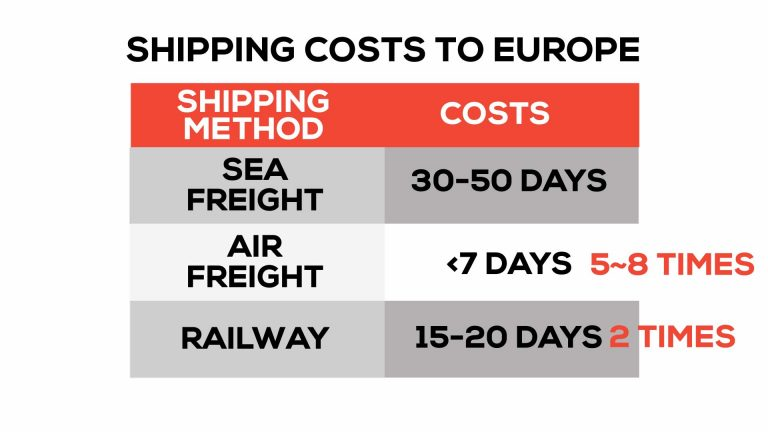
Advantages of rail freight
- Ideal: For Eastern European and West Asian countries that are far from seaports and rely on inland transportation, rail freight is the ideal choice.
- Balance of time and cost: Rail transportation costs about twice as much as ocean freight, but its transit time is dramatically reduced to 15-20 days, half the time of ocean freight. This time advantage is crucial for easing cash flow pressures and improving supply chain efficiency.
Challenges of rail freight
- Limited access to countries: Despite its many advantages, the biggest drawback of rail freight is the relatively limited range of countries along the Central European Railway, which restricts its widespread use.
- Full load requirement: Currently, most freight forwarders do not allow sharing of containers, meaning that you must ship your products in fully loaded containers. This requirement poses a challenge for small importers and adds to the difficulty and cost of transportation.
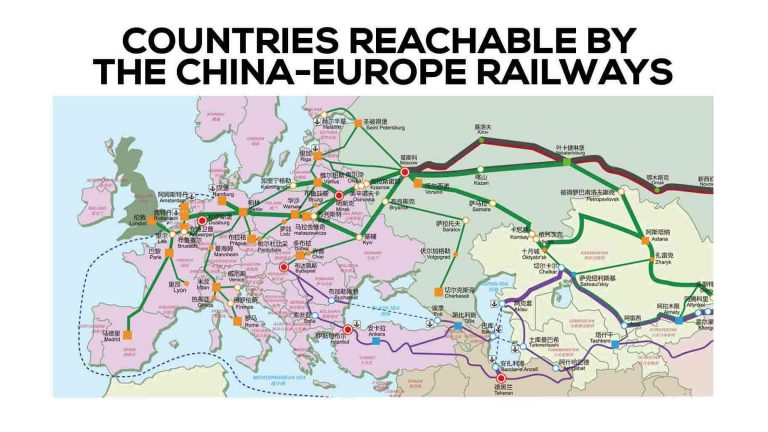
Despite demonstrating significant time and cost advantages, demand for rail freight remains modest. This is mainly attributed to the transportation requirement of full containers, which limits the participation and flexibility of small importers. In the future, with the continuous improvement of the rail network and the adjustment of freight forwarding policies, rail freight is expected to attract more customers and become an important link between East and West trade.
VII. Maritime and Express Convergence Solutions for E-Commerce
In the field of e-commerce, choosing the right mode of transportation is crucial. In terms of cost and time considerations, the various modes of transportation have their own merits:
- Sea freight: the most economical, but time-consuming (more than a month), and suitable for large quantities of goods over 2CBM.
- Air transportation: fast, suitable for small and light goods under 500kg, but the cost is high, about 5-8 times of sea transportation.
- Railroad: performs well in terms of time and cost, but needs to be fully loaded for transportation, and cannot reach the United States directly.
In view of this, in recent years, some innovative freight forwarding companies cleverly combine sea freight with express delivery services to provide e-commerce sellers with more flexible transportation solutions.
Ocean + Express Convergence Programs
These freight forwarders help customers share a container to the West Coast of the United States, and then by the local courier company (such as UPS) from the port to the designated address within the United States. The advantages of this program are:
- Viable for small quantities: even small shipments of only 50-100 kilograms can be transported smoothly, which is unmatched by ordinary ocean LCL (Less-than-Consolidated Container) shipments.
- Cost-effective: the total freight cost is about 2 USD/kg, which is slightly higher (about 2 times) than ordinary ocean freight, but more cost-effective.
- Fast delivery: the transportation time from China port to the final destination in the US is only about 20 days, which is 20%-50% faster than ordinary ocean freight.
**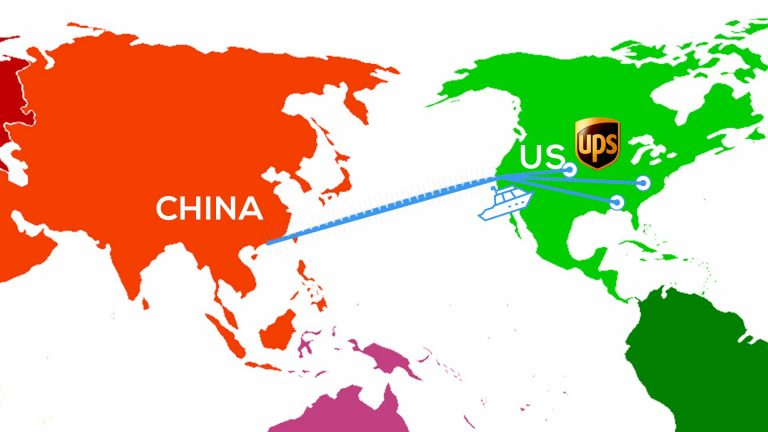
Airfreight + courier fusion solutions
There is also a solution that combines air transportation with a local courier company. Compared with air courier, the cost of this solution is reduced by about 20%, although the speed is a few days slower, but it is still an efficient and economical choice.
The above solution is not only applicable to the United States, but also widely applicable to the United Kingdom, Germany and other countries with Amazon distribution centers. It is designed for Amazon sellers, especially those who want to ship small quantities of goods to Amazon warehouses quickly and economically. For the European market, some freight forwarders even combine rail freight with express delivery services, providing e-commerce sellers with more diversified transportation options.
In summary, the converged solutions of ocean freight and express, air freight and express, and rail and express have become the preferred choice for e-commerce sellers, especially Amazon FBA sellers. These solutions are not only affordable, but also suitable for the transportation of small goods. If you are interested in adopting such transportation solutions, it is recommended to consult a freight forwarder located in China and focusing on Amazon shipping for more professional advice and services.
VIII. E-package (under 2kg) solutions for shipment on behalf of customers
In previous content, we have explored solutions for shipments over 20 kilograms per shipment. However, for most packages weighing less than 1 kilogram, direct sellers often struggle to afford the high cost of air freight. Even sending a single sheet of paper can cost as much as $20 USD minimum. Instead of keeping inventory, direct sellers tend to want suppliers to ship directly from China.In response to this need, Epackage was created, making it an ideal choice for direct sellers.
How Epackage Works
In China, the most well-known of the ePackage service providers are China Post and Yanwen. These service providers ship countless parcels from China to the destination country by air, and then utilize the local postal service for the final delivery.
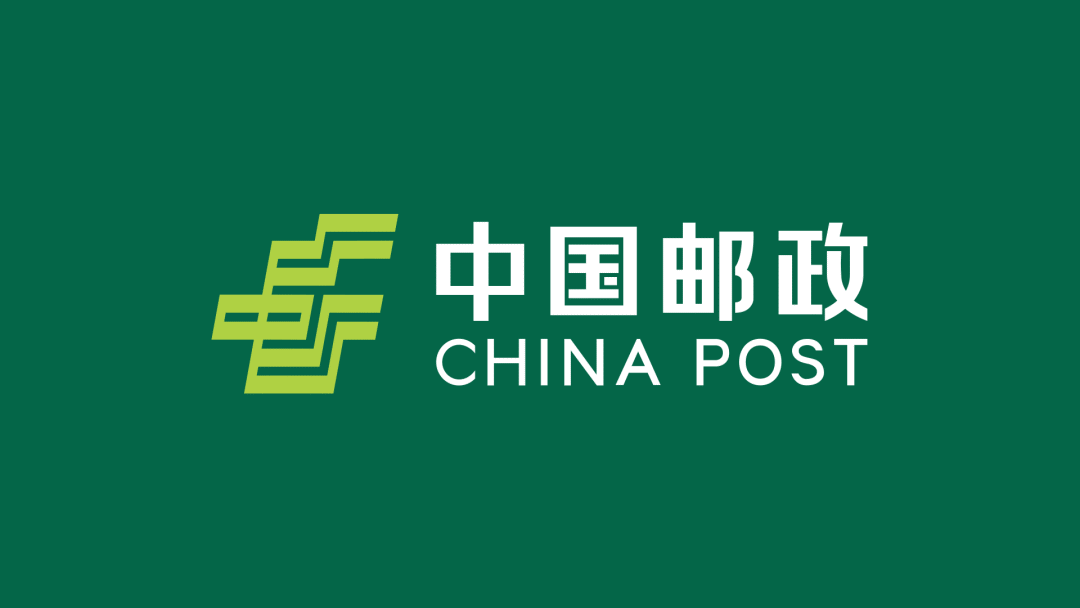
Advantages of Epackage
- Low Starting Weight: The biggest advantage of Epackage is that its minimum starting weight is only 20 grams, and shipping costs are charged on a per gram basis. This feature makes it perfect for shipping small items and cheap fashion jewelry.
- Widely used: all direct sellers, Wish and Aliexpress sellers are using this shipping method, proving its reliability and usefulness.
Disadvantages of Epackage
Despite the fact that Epackage offers a cheap shipping solution, it has some shortcomings. Compared to air express, Epackage’s shipping is slower and less consistent, usually taking 10-20 days. In addition, sometimes packages can get lost.
Parcel cost inquiry
In order to get the most accurate information about the parcel cost, it is recommended to check the website of the famous ePackage company Yannwen. All you need to do is to fill in the countries of origin and destination, as well as the estimated weight of each parcel, and you will get a list of quotes for eParcel solutions offered by different companies. Among them, EUB (China Post e-Parcel) is a provider worth referring to.
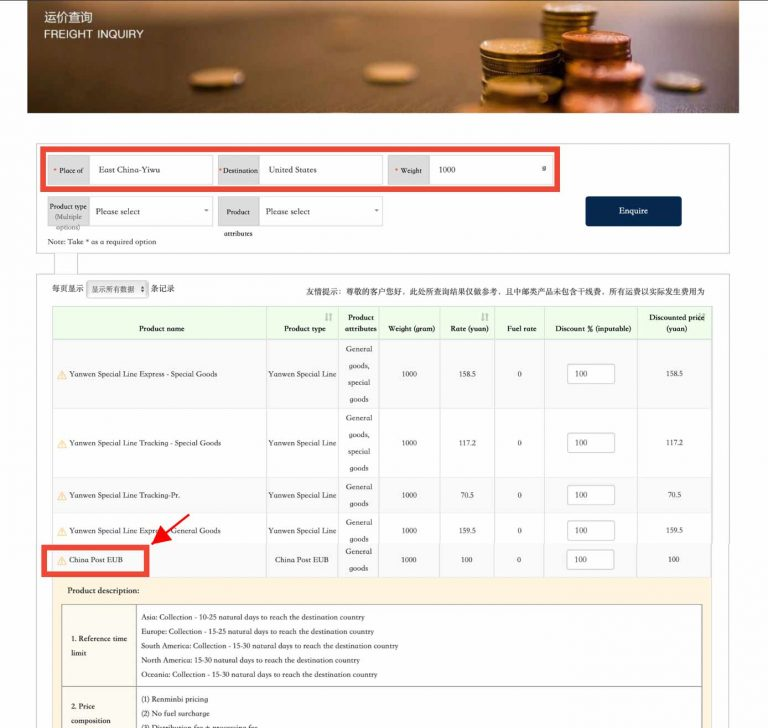
How to ship products via Epackage?
Although most of the Chinese suppliers that offer direct sales services are associated with ePackage, if you want to order products in bulk from a manufacturer or wholesale supplier that does not offer direct sales delivery services, it is best to find a distribution center in China or contact our company for assistance. It is important to note that eParcel companies are only responsible for transportation services and do not provide distribution services.
IX. Handling China Customs Clearance Process
Customs clearance is an integral part of importing and exporting goods in international trade. Understanding the documents and certificates required for customs clearance is essential to ensure a smooth transaction.
Documents Required for China Export Customs Clearance
When exporting goods from China, the following documents are essential:
- Contracts: specify the rights and obligations of the buyer and seller.
- Commercial invoice: detailing information about the goods, price and terms of the transaction.
- Packing list: accurately describes the content and quantity of the goods.
- Bill of Lading (or Bill of Lading): a document that proves ownership of the goods and instructs the carrier to deliver the goods to the named consignee.
- Certificate of Origin: an official document that proves the origin of the goods and helps to enjoy tariff preferences.
Additional certificates may also be required depending on customs regulatory requirements for different products. However, usually the supplier will assist in these matters to ease your burden.
Importing Country Customs Clearance Requirements
The same set of standard documents are required for import customs clearance in your country/region, including but not limited to:
- Commercial invoice
- Contracts
- Packing list
- Bill of Lading
- Certificate of Origin
Meanwhile, other specific certificates may be required depending on the specific country or product characteristics. In order to obtain the most accurate information, it is recommended to consult a professional freight forwarder or customs broker.
Tariff Payment
In addition to the preparation of documents, payment of customs duties is also an important part of the customs clearance process. Tariff rates vary from country to country or product to product. For example, if you are importing shoes from China to the U.S., you will need to pay the Merchandise Processing Fee (MPF) and the Harbor Maintenance Fee (HMF) in addition to the tariff.
In order to fully understand the required documents and tariff rates, you are advised to consult a professional freight forwarder or customs broker who will provide you with professional guidance and assistance.
Summarize
We hope this article can provide valuable reference for you to deal with China customs clearance and enhance your confidence in making decisions. If you have any questions or need further information on the topic of this article, please leave a comment below.
As a leading sourcing company in China, we are committed to helping our customers find quality manufacturers, ensure product quality, and arrange delivery to their doorsteps to make the sourcing process easier and safer. If you have a need to source products from China, please feel free to contact us and we will be happy to serve you.
